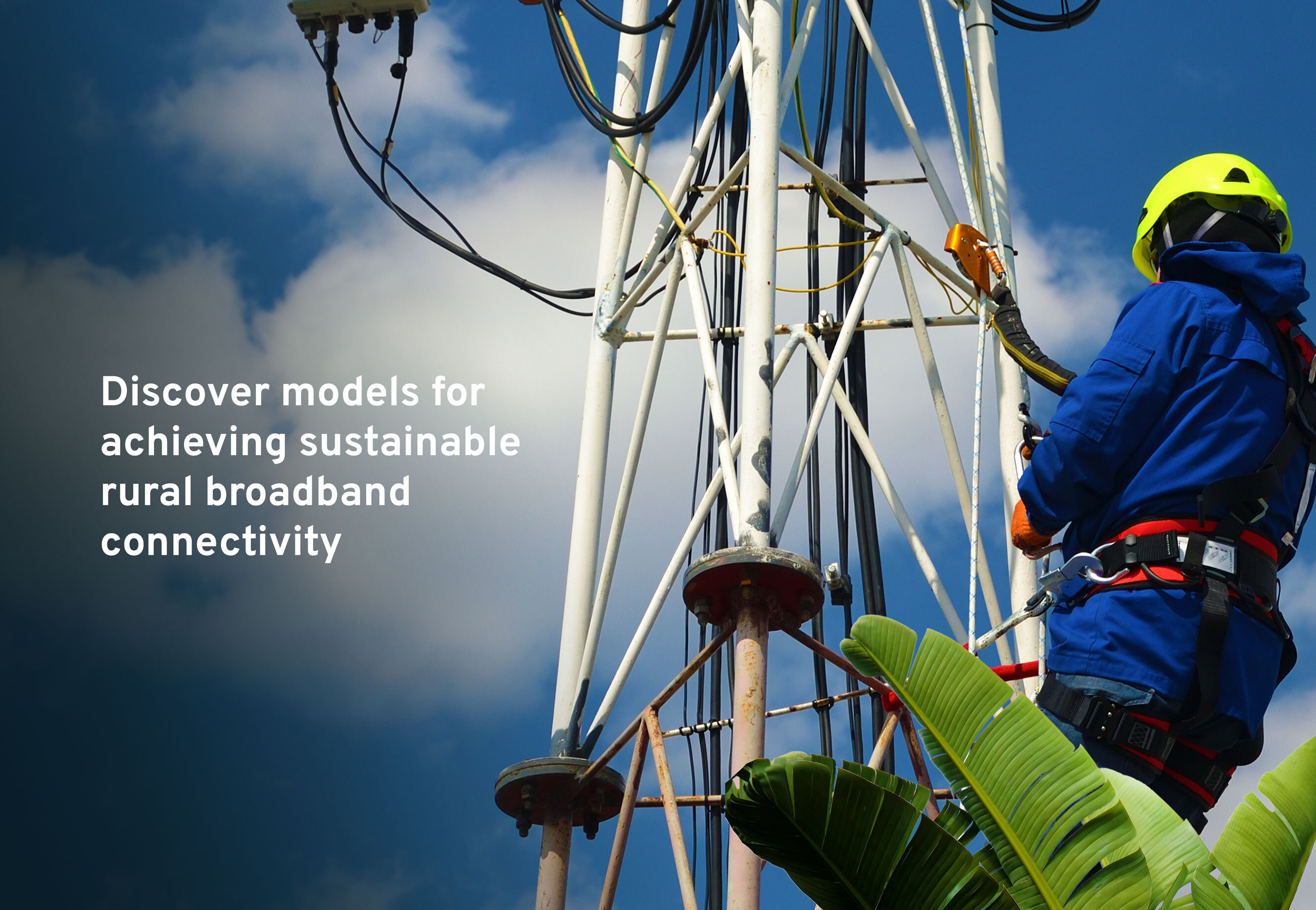
Access to high-speed internet is essential for economic development, education, healthcare, and social inclusion. However, rural areas often face significant challenges in achieving reliable broadband connectivity for several reasons, including low population density, difficult terrain, and limited infrastructure. This has created a big digital divide, which isolates rural dwellers from essential online resources and opportunities. So, what’s the solution?
The answer is in sustainable rural broadband connectivity. There is a need to prioritize sustainable, long-term, affordable broadband connectivity in rural areas. Without this, the rural population risks falling further behind in an increasingly digital world, perpetuating inclusion disparities and hindering economic opportunities and development.
However, sustainable rural broadband connectivity requires innovative models that address these unique challenges.
This article explores some of the best models for achieving sustainable rural broadband connectivity.
Models for achieving sustainable rural broadband connectivity.
1. Community Networks
Community networks are grassroots initiatives where local communities build, own, and manage their broadband infrastructure. These networks leverage local knowledge and resources, making them particularly effective in areas where traditional telecom operators may not find it economically viable to operate. Community networks emphasize local ownership and empowerment, fostering a sense of community and resilience.
2. Wireless Internet Service Providers (WISPs)
Wireless Internet Service Providers (WISPs) use wireless technology to deliver broadband services, often utilizing spectrum in the unlicensed 2.4GHz and 5GHz bands. This model is cost-effective and adaptable to various terrains, providing the opportunity to provide sustainable rural broadband connectivity. WISPs offer flexibility and rapid deployment, making them suitable for diverse rural environments.
3. Public-Private Partnerships (PPPs)
Rural areas can also get sustainable rural broadband connectivity through Public-Private Partnerships (PPPs). PPPs involve collaboration between government entities and private companies to expand broadband infrastructure. Governments provide subsidies, grants, or other incentives to encourage private investment in rural areas. PPPs combine the strengths of public oversight and private sector efficiency, often leading to sustainable and scalable solutions. A notable example in Kenya includes the National Optic Fibre Backbone Infrastructure (NOFBI), a government initiative to enhance connectivity across the country by laying down fiber-optic cables, which private companies can then use to provide connectivity and digital services.
4. Satellite Broadband
Satellite broadband offers a viable solution for providing connectivity in remote and hard-to-reach areas where terrestrial infrastructure is impractical. Satellite broadband ensures wide coverage and can be deployed quickly, making it an excellent option for bridging the digital divide, particularly in remote areas. Advancements in satellite technology, such as low Earth orbit (LEO) satellites, have made this option more affordable and effective. Examples include:
- Starlink by SpaceX: This LEO satellite network provides high-speed internet globally, including remote rural areas.
- OneWeb: Another LEO satellite network aiming to deliver global broadband coverage.
5. Fiber to the Home (FTTH) with Subsidies
Deploying fiber optics directly to homes in rural areas can be prohibitively expensive, but government subsidies and incentives can make it feasible. This model ensures a high-speed and future-proof solution for sustainable rural broadband connectivity. FTTH provides the highest quality of service, offering reliable and fast internet connections.
6. Hybrid Models
Hybrid models combine different technologies and approaches to achieve comprehensive coverage and provide rural broadband connectivity. For example, these models might use fiber to the node combined with wireless links to reach the final user. Hybrid models are versatile and can be tailored to the specific needs of different rural areas.

Key Considerations for Sustainability in Rural Broadband Connectivity
Achieving sustainable rural broadband connectivity is crucial for ensuring that rural communities can access the same economic, educational, and social opportunities as urban areas. However, the sustainability of these initiatives hinges on several key considerations that must be meticulously addressed. These include:
1. Affordability
Affordability is paramount when considering the access of rural broadband connectivity services to all population segments. This includes the initial cost of infrastructure deployment and the ongoing costs for end-users. Strategies to ensure the affordability of rural broadband connectivity include:
- Subsidies and Grants: Governments and international organizations can provide financial support to lower the costs of deploying and maintaining broadband infrastructure.
- Low-Cost Service Plans: Providers can offer tiered pricing models to cater to different income levels, ensuring that basic internet access remains affordable.
- Shared Access Models: Community networks and shared access points (e.g., Wi-Fi hotspots) can distribute costs among many users, reducing individual expenses.
2. Scalability
Scalability is a key driving factor when considering the sustainability of Rural Broadband Connectivity. Scalability refers to the ability of the broadband infrastructure to grow and adapt to increasing demand, changing infrastructure, and technological advancements. Scalable solutions ensure long-term sustainability and relevance, which is important to rural connectivity. Key aspects of scalable rural broadband connectivity include:
- Modular Infrastructure: Building infrastructure that can be easily upgraded or expanded as demand grows.
- Future-Proof Technology: Investing in technologies that can accommodate future upgrades without requiring complete overhauls.
- Flexible Business Models: Developing business models that can scale with user growth and evolving market conditions.
3. Local Involvement
Local involvement is critical for successfully deploying and sustaining rural broadband connectivity initiatives. Engaging local communities in the planning, implementing, and managing of broadband networks can lead to higher adoption rates and better maintenance. Considerations for local involvement of rural broadband connectivity initiatives include:
- Community Engagement: Involving local leaders and residents in decision-making processes to ensure the network meets their needs.
- Capacity Building: Providing training and resources to local communities to manage and maintain the infrastructure.
- Employment Opportunities: Creating jobs related to deploying and maintaining broadband networks within the community.
4. Regulatory Support
Regulatory support from governments is essential for creating an enabling environment for rural broadband deployment. Policymakers must prioritize sustainable, long-term solutions and funding to address the urgent need for affordable broadband connectivity in rural areas. Short-term measures only perpetuate uncertainty and fail to provide the stability for meaningful progress.
Favorable policies and regulations can encourage investment and innovation. Key regulatory considerations in facilitating rural broadband connectivity include:
- Spectrum Allocation: Ensuring that adequate spectrum is available for rural broadband services, particularly for wireless technologies.
- Incentives for Investment: Offering tax breaks, subsidies, or other incentives to companies that invest in rural broadband infrastructure.
- Streamlined Permitting Processes: Simplifying the process for obtaining permits and licenses required for infrastructure deployment.
5. Technological Adaptability
Technological adaptability involves using a mix of technologies to address the diverse challenges of rural broadband connectivity. Different technologies can complement each other to provide comprehensive rural internet coverage. Key considerations include:
- Hybrid Solutions: Combining various technologies such as fiber, wireless, and satellite to provide the most effective coverage.
- Context-Specific Solutions: Adapting technology choices to different rural areas' specific needs and conditions (e.g., terrain, population density).
- Innovation and Experimentation: Encouraging the adoption of new and emerging technologies that could provide more efficient or cost-effective solutions.
6. Environmental Impact
Environmental impact is an increasingly important consideration for sustainable development, including sustainable rural broadband connectivity. Deploying broadband infrastructure should minimize negative environmental effects and promote sustainability. Key aspects include:
- Energy Efficiency: Using energy-efficient technologies and renewable energy sources to power broadband infrastructure.
- Minimal Disruption: Choosing deployment methods that minimize disruption to the local environment and biodiversity.
- Sustainable Practices: Encouraging recycling and the use of eco-friendly materials in the construction and maintenance of broadband infrastructure.

Driving Digital Inclusion: Sustainable Broadband for Rural Development
Sustainable rural broadband connectivity requires a multifaceted approach that leverages various models and technologies. We’ve seen that Community networks, PPPs, satellite broadband, WISPs, FTTH with subsidies, and hybrid models all offer viable solutions for bridging the digital divide. By considering affordability, scalability, local involvement, regulatory support, and technological adaptability, we can create sustainable and resilient broadband networks that empower rural communities and drive inclusive development.
By integrating these factors into the planning and implementation of rural broadband projects, stakeholders can create resilient and enduring broadband solutions that empower rural communities, drive inclusive development, and foster socio-economic growth.
Latest Articles
Tue Dec 09 2025
Why MikroTik Should Be in Your 2026 Network PlanMon Oct 13 2025
Netgate pfSense+ Security Gateways: The Security Gateway Built for the Demands of Modern EducationWed Sep 03 2025
hello worldRelated Articles
.jpg)
ePMP 3000 - 5X Performance with Gen3 Technology
-(1).png)
Africa Tech Festival Displays Strides in Connectivity and Telecommunications Infrastructure across Africa

Cambium Networks ePMP Force 425 - The Industry’s First Point-to-Point Solution Based on 802.11ax

The Power of OFDMA in Wireless Broadband
In this article, we delve into the principles of OFDMA, the defining principle of the 802.11ax standard, its applications, and its impact on wireless broadband.

© 2025 PoweredbyOptace Networks Limited. All Rights Reserved.
